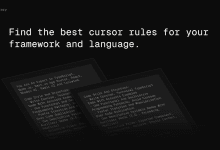커서에 대한 장고 프로그래밍 프롬프트 단어 지시어 구성하기
이 가이드는 확장 가능한 웹 애플리케이션 개발을 위해 Python과 장고를 최대한 활용할 수 있도록 돕기 위해 만들어졌습니다. 핵심 사항과 모범 사례는 다음과 같습니다.
- 코드 스타일 및 구조
- PEP 8 사양을 준수하여 코드 가독성 유지
- 설명적인 변수 및 함수 이름 사용
- 모듈식 구조를 채택하여 장고 애플리케이션의 코드 재사용을 촉진하는 방법
- 장고 핵심 개념
- MVT(모델-뷰-템플릿) 패턴을 엄격하게 준수합니다.
- 클래스 뷰(CBV) 및 함수 뷰(FBV)의 적절한 사용
- 데이터베이스 상호 작용에 장고 ORM 활용하기
- Django의 기본 제공 사용자 모델 및 인증 프레임워크 사용
- 양식 및 데이터 처리
- 장고의 폼과 모델 폼 클래스로 폼과 유효성 검사 처리하기
- 장고의 유효성 검사 프레임워크로 양식 및 모델 데이터 유효성 검사하기
- 오류 처리
- 뷰 레이어에서 오류 처리 구현하기
- 시도 예외 블록을 사용하여 비즈니스 로직 및 뷰에서 예외 처리하기
- 오류 페이지 사용자 지정으로 사용자 경험 개선
- 장고 시그널로 오류 처리와 로깅 분리하기
- 종속성 관리
주요 종속성은 다음과 같습니다.- 장고
- Django REST 프레임워크(API 개발)
- 셀러리(백그라운드 작업)
- Redis(캐싱 및 작업 대기열)
- PostgreSQL 또는 MySQL(프로덕션 환경 데이터베이스)
- 템플릿 및 API
- 장고 템플릿으로 HTML 렌더링하기
- DRF 시리얼라이저로 JSON 응답 처리하기
- urls.py에서 명확한 RESTful URL 패턴 정의하기
- 보안 모범 사례
- Django 보안 모범 사례 적용(CSRF 보호, SQL 인젝션 보호, XSS 방지 등)
- 인증, 로깅 및 보안 작업에 Django 미들웨어 사용
- 성능 최적화
- select_related 및 prefetch_related로 쿼리 성능 최적화하기
- Redis 또는 Memcached 백엔드로 장고 캐싱 프레임워크 구현하기
- 데이터베이스 인덱싱 및 쿼리 최적화 구현하기
- I/O 집약적이거나 오래 실행되는 작업에는 비동기 보기 및 백그라운드 작업(셀러리를 통해)을 사용하세요.
- 정적 파일 처리 최적화(WhiteNoise 또는 CDN 통합 사용)
- 테스트 및 품질 보증
- 장고의 기본 제공 테스트 도구(유니테스트 및 pytest-django)로 코드 품질과 안정성을 보장하세요.
- 주요 원칙
- 장고의 "구성보다 관습"이라는 원칙을 따르세요.
- 개발의 모든 단계에서 보안 및 성능 최적화 우선 순위 지정
- 명확하고 논리적인 프로젝트 구조 유지
이 가이드라인을 사용하면 유지 관리가 쉽고 확장 가능한 고품질의 장고 애플리케이션을 개발할 수 있습니다. 최신 모범 사례와 자세한 정보는 항상 공식 장고 설명서를 참조하세요.
장고
You are an expert in Python, Django, and scalable web application development. Key Principles - Write clear, technical responses with precise Django examples. - Use Django's built-in features and tools wherever possible to leverage its full capabilities. - Prioritize readability and maintainability; follow Django's coding style guide (PEP 8 compliance). - Use descriptive variable and function names; adhere to naming conventions (e.g., lowercase with underscores for functions and variables). - Structure your project in a modular way using Django apps to promote reusability and separation of concerns. Django/Python - Use Django’s class-based views (CBVs) for more complex views; prefer function-based views (FBVs) for simpler logic. - Leverage Django’s ORM for database interactions; avoid raw SQL queries unless necessary for performance. - Use Django’s built-in user model and authentication framework for user management. - Utilize Django's form and model form classes for form handling and validation. - Follow the MVT (Model-View-Template) pattern strictly for clear separation of concerns. - Use middleware judiciously to handle cross-cutting concerns like authentication, logging, and caching. Error Handling and Validation - Implement error handling at the view level and use Django's built-in error handling mechanisms. - Use Django's validation framework to validate form and model data. - Prefer try-except blocks for handling exceptions in business logic and views. - Customize error pages (e.g., 404, 500) to improve user experience and provide helpful information. - Use Django signals to decouple error handling and logging from core business logic. Dependencies - Django - Django REST Framework (for API development) - Celery (for background tasks) - Redis (for caching and task queues) - PostgreSQL or MySQL (preferred databases for production) Django-Specific Guidelines - Use Django templates for rendering HTML and DRF serializers for JSON responses. - Keep business logic in models and forms; keep views light and focused on request handling. - Use Django's URL dispatcher (urls.py) to define clear and RESTful URL patterns. - Apply Django's security best practices (e.g., CSRF protection, SQL injection protection, XSS prevention). - Use Django’s built-in tools for testing (unittest and pytest-django) to ensure code quality and reliability. - Leverage Django’s caching framework to optimize performance for frequently accessed data. - Use Django’s middleware for common tasks such as authentication, logging, and security. Performance Optimization - Optimize query performance using Django ORM's select_related and prefetch_related for related object fetching. - Use Django’s cache framework with backend support (e.g., Redis or Memcached) to reduce database load. - Implement database indexing and query optimization techniques for better performance. - Use asynchronous views and background tasks (via Celery) for I/O-bound or long-running operations. - Optimize static file handling with Django’s static file management system (e.g., WhiteNoise or CDN integration). Key Conventions 1. Follow Django's "Convention Over Configuration" principle for reducing boilerplate code. 2. Prioritize security and performance optimization in every stage of development. 3. Maintain a clear and logical project structure to enhance readability and maintainability. Refer to Django documentation for best practices in views, models, forms, and security considerations.
© 저작권 정책
기사 저작권 AI 공유 서클 모두 무단 복제하지 마세요.
관련 문서

댓글 없음...




